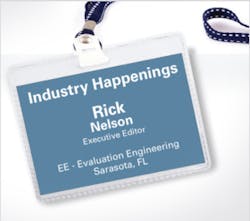BiTS workshop emphasizes IoT, high-frequency test
The Burn-in and Test Strategies Workshop 2016 took place March 6-9 in Mesa, AZ. It commenced with a tutorial on adaptive test, outlier analysis, and burn-in reduction/elimination and continued throughout the week with an invited address, keynote speech, eight technical sessions, a poster session, and 47 companies presenting their wares on the exhibit floor.
The Internet of Things was a focus of the BiTS opening technical session. Laurie Wright of Xcerra discussed how the IoT will change backend processing. Anthony Lum of Advantest commented on how to contend with high-mix, low- to moderate-volume devices. And Robert Howell from Exatron described serialization techniques for high-volume IoT security.
High-frequency test also was a key topic at BiTS. Kicking off a related session, Don Thompson of R&D Altanova brought his company’s perspective as a load-board supplier to the topic. According to Thompson, customers specifying sockets often focus on reliability, repairability, and cost but overlook signal-integrity and power-integrity issues.
Also addressing BGA sockets was Noureen Sajid of Johnstech International, who emphasized that an RF test system must incorporate a contactor that has validated RF performance comparable to that of the device under test. She described a BGA package soldered to a 50-Ω load board, simulated using ANSYS HFSS modeling.
FCBGA and WLCSP sockets for an 81-GHz automotive radar test cell were the topics of Jason Mroczkowski of Xcerra. He described progress since his presentation at last year’s BiTS. Challenges, he said, include doing test development without DUTs being available and tri-temp handling at 80 GHz. In fact, he said, “Everything is critical at 80 GHz.” Over the past year, he said, his team has demonstrated a 76-GHz to 81-GHz instrument with an mmWave socket and correlated results on three independent testers.
Hiroyuki Yamakoshi of S.E.R. Corp. delivered a talk on blind signal analysis using YOROI, which samurai wore to prepare for fighting. Similarly, he said, a signal probe socket (or interposer) must be prepared to measure >3.5-Gb/s blind signals on 0.8-mm-pitch devices. The approach involves socket S-parameter data in conjunction with Keysight Technologies’ InfiniiSim technology.
In another session, Jason Cullen of Plastronics noted that for thermal management and control we often use ovens with digital displays, but should we trust them? “The answer is absolutely not,” he said, noting that we use meat thermometers when roasting a chicken or perhaps poke a cake with a toothpick to see whether it’s done. For burn-in, he said, we can model the effects of heat and temperature distribution.
Next up, Edwin Valderama of Intel discussed WLCSP tri-temp test for RF and non-RF products. He focused on issues such as Pogo-tower setup vs. direct docking, RF bridge beam on a V93000 tester vs. a digital bridge beam, and probe needle vs. Pogo pin. Other issues investigated included hardware planarity, PCB warpage, and optimum test-site layout.
The final technical presentation of BiTS 2016 was titled “A Silicon Photonics Wafer Probing Test Cell.” Jose Moreira of Advantest described work done by his company as well as Tokyo Electron and STMicroelectronics. Moreira detailed test requirements, probing considerations, volume production challenges, test cell issues, and software requirements.
Preceding the technical sessions, BiTS general chair Ira Feldman delivered a marketplace report, in which he cited figures from John West at VLSIresearch, forecasting a 3.8% CAGR through 2020 (2.6% for burn-in sockets and 4.4% for test sockets). The top five manufacturers, who account for roughly half of the market, include Yamaichi Electronics, Enplas Tech Solutions, Sensata Technologies, ISC, and Leeno Industrial, all of whom exhibited at BiTS.
Also exhibiting sockets were Aries Electronics, which offers BGA and LGA sockets for test and burn-in; Cohu ITS, which makes spring pins and contactors; E-tec Interconnect AG, which designs and manufactures elastomer and probe-pin test sockets; HSIO, which offers Grypper socket products; J2M Test Solutions, which provides custom test sockets and interconnects for lab and production environments; Micro Contact Solution, which manufactures rubber/elastomer sockets and SSD connectors; MJC Electronics, which offers test sockets for leaded and SMT devices; Phoenix Test Arrays, which makes products ranging from characterization sockets to final-test contactors; Qualmax, which produces spring probes and test sockets; Rika Denshi, which manufactures test probes for test and burn-in sockets; TSE Co., which offers load boards and test sockets; WinWay Technology, which provides test sockets and probe cards; TwinSolution, which supplies IC test sockets and spring probes; and Xcerra, which offers Multitest contactors.
Companies exhibiting related products included DuPont Vespel, which makes socket blanks; E. Jordan Brooks Co., which develops engineering plastics for the burn-in and test socket industry; Kita USA, which offers test probes and ATE connectors; Semiconductor Test Supply, which designs and assembles burn-in and evaluation boards; Smiths Connectors, which provides probe heads and package test solutions; and Sun Electric Heater, which offers miniature cartridge heaters for burn-in socket applications.
Equipment makers also were on hand to describe their systems. Astronics highlighted its ATS 503X turnkey burn-in test platform for thermal stress test. Aehr Test Systems described its systems for burn-in and test of memory and logic ICs. inTest highlighted its manipulator, docking, and interface capabilities, including temperature management. Incal Technologies displayed its burn-in systems for semiconductor final test. ELES showcased its burn-in systems for automotive, MEMS, and other applications. And Micro Control featured its burn-in solutions, which support from 0 to 600 W per device.
BiTS 2017 will take place March 5-8 in Mesa.
About the Author

Rick Nelson
Contributing Editor
Rick is currently Contributing Technical Editor. He was Executive Editor for EE in 2011-2018. Previously he served on several publications, including EDN and Vision Systems Design, and has received awards for signed editorials from the American Society of Business Publication Editors. He began as a design engineer at General Electric and Litton Industries and earned a BSEE degree from Penn State.
